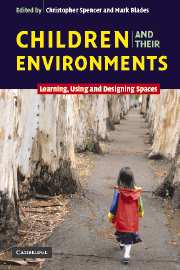Book contents
- Frontmatter
- Contents
- Notes on contributors
- An introduction
- Part I Children's understanding of places
- Part II Children's experience of places
- Part III Adolescents' worlds?
- Part IV Children and the design process
- 12 Children as agents in sustainable development: the ecology of competence
- 13 Children and city design: proactive process and the ‘renewal’ of childhood
- 14 A learning-based network approach to urban planning with young people
- 15 Young people's participation in constructing a socially just public sphere
- Index
- References
14 - A learning-based network approach to urban planning with young people
Published online by Cambridge University Press: 23 October 2009
- Frontmatter
- Contents
- Notes on contributors
- An introduction
- Part I Children's understanding of places
- Part II Children's experience of places
- Part III Adolescents' worlds?
- Part IV Children and the design process
- 12 Children as agents in sustainable development: the ecology of competence
- 13 Children and city design: proactive process and the ‘renewal’ of childhood
- 14 A learning-based network approach to urban planning with young people
- 15 Young people's participation in constructing a socially just public sphere
- Index
- References
Summary
Introduction: the context of planning with young people
Citizens of the Western industrialized world are increasingly living in informational network societies. Castells (1996) states that the latter are characterized by the spaces of global flows of information, finances, and technology which subjugate localities and places. This means that new challenges are posed to urban and rural policies, including planning and development. Local areas are increasingly seen as part of regions which are forced to compete with one another to become attractive spaces for desired activities. The winners of this competition are those who have the know-how to take advantage of the opportunities of globalization. One of the strategies that has been applied in the competition for economic survival is the building of regional development networks (Kostiainen, 2002). Such networks might ultimately turn into lucrative regional innovation systems that will bring forth new economic activities and consequent material gains. The actors in these networks of competitiveness are usually ‘big players’, such as enterprises, public institutions, financial agents, and universities (Cook et al., 2000).
The losers in the globalization game are those who are unable to cope with the negative impact of globalization, and who lack the control over and voice in local matters. The negative effects of globalization can be felt not only in developing countries, but also in many Western nations, and especially in the everyday lives of children, young, and elderly people, and many women.
- Type
- Chapter
- Information
- Children and their EnvironmentsLearning, Using and Designing Spaces, pp. 238 - 255Publisher: Cambridge University PressPrint publication year: 2006
References
- 10
- Cited by

